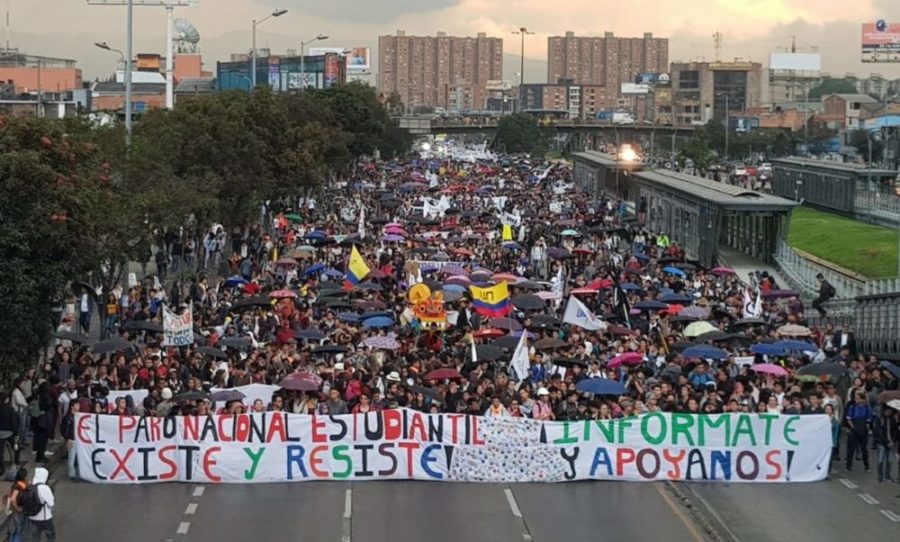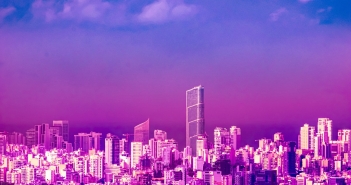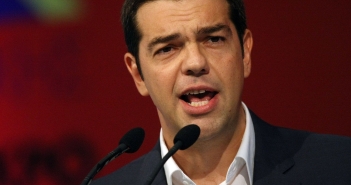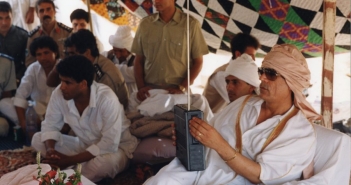A national strike was called in Colombia for Thursday, the 21st of November. In Bogotá, it would be the beginning of two weeks of protests, parties, and panics.
Iván Duque, Colombia’s right-wing president, was elected in 2018. Since then he has tried to implement the typical Latin American neo-liberal programme: pension privatisation; privatisation of government agencies; cuts to education budgets; cuts to corporation tax; cuts to the minimum wage for young people; the violent suppression of the left; the violation of peace treaties; the murder of social leaders. The strikes are a response to that programme.
Bouncing in the spotlight of the Andean sun
The marches began on Thursday morning. Thousands walked along the main routes into the centre of the city. Approaching from a few streets over, it sounded like the noise from a football stadium. There was music and whistles and horns. Crowds bounced in the spotlight of the Andean sun. Police helicopters hovered over the tree-topped mountains which enclose the city. Theatre groups twirled white flags like batons. Trapeze artists hung red ribbons from bridges and performed for the crowds passing underneath. The multi-coloured indigenous flag – the Wiphala – sparkled in the sunshine. The flags of over fifty trade unions waved above the walking crowds. Topless protestors posed for photographs. People in traditional indigenous clothes played music and danced in a circle. Fireworks went off.
One group of marchers carried a naked, blood-covered doll to represent the eight children who had been killed in August by the Colombian military.[i]
There were pictures of pigs everywhere. The president, whenever he appears on television, has a bewildered look that is made worse by the porcine upturn of his nose. There were pig masks, pig posters, pig flags, people dressed as pigs, the president’s face on the body of a pig, a puppet of a pig being controlled by Álvaro Uribe.

President Donald J. Trump shakes hands with the President of the Republic of Colombia Ivan Duque Marquez prior to participating in a bilateral meeting Tuesday, Sept. 25, 2018, at the United Nations Headquarters in New York. (Official White House Photo by Shealah Craighead)
Mr. Duque is widely considered to be a proxy for Mr. Uribe, the influential former president. The name Uribe alone evokes, for some Colombians, images of death squads, narco money, pro-business corruption, and the genocide of poor and indigenous people. For others, Uribe means safety, progress, prosperity, and victory over left-wing terrorists.
In a surprise move, students from the National University of Colombia turned west to block the airport. The were stopped along the route by ESMAD, Colombia’s controversial riot police unit.[ii] The riot police fired teargas and stun grenades. The students held their hands up and chanted Sin violencia, both a statement of intent and an accusation directed at the riot police’s reputation for brutality.
The rest of the marches continued on towards Plaza Bolívar, the historic centre of Bogotá. The protestors stood around in the early afternoon as the sky darkened. They listened to the shouts of the anti-government speeches from a stage at the top of the plaza. The trouble started when the rain started falling.
Some of the protestors pulled down the black cloth which had been put up to protect the historic buildings around the plaza. They burned the black cloth in the shelter of stone pillars. The riot police cleared the plaza with teargas and stun grenades. The water cannon trucks, black and square and as slow as tanks from the first world war, rolled in and sprayed the remaining protestors out into the narrow streets nearby. They would fight their way back into the plaza and be repelled again many times over the next few hours.
Fires burned at intersections
The rain continued to fall. The televisions stations divided their screens in four to show the different riots across the city. The police sirens kept a high pitched background beat as the TV presenters described the rioting.
Stones were smashed on the ground and broken into smaller pieces and thrown at the riot police. Teargas was fired, the canisters skipped over the wet streets with a trail of white smoke behind them. The smoking canisters were picked up and thrown back towards the riot police. The water cannon trucks were surrounded and attacked and sprayed with graffiti and pounded with stones.
Bus stations were smashed up with hammers. Fires burned at intersections in working class suburbs, the smoke could be seen from across the city. People with hoods up and their faces covered with scarves ran at the riot police and ran back as the riot police advanced. They chased each other up and down the streets as it got dark.
They chased each other up and down the television screens in the wealthier northern suburbs where nobody protests. Bogotá is used to such scenes. Rain. Plumes of teargas. Scarfs across faces. Smashed glass. Smashed stones. The streets in the rain soaked north, by comparison, were silent. Christmas trees flickered in the windows of multi-story apartment blocks. In the empty bars and the empty restaurants, bored staff watched the riots on television. There was an empty feeling in the streets like in the days after Christmas.
For many people in the north of the city, they first heard the distinctive sound of what became known as the ‘Cacerolazo’ from their phones. They saw videos of pots and pans being banged in protest on WhatsApp or Twitter or Facebook.
It was only when they opened their windows or stepped out onto their balconies that they heard the tinklings of this new protest in the buildings around them. Windows which had previously been lights on the skyline revealed people, more and more as the night went on, banging pots and pans.
It was happening all over the divided city. Videos of it went viral. The president held a press conference to denounce the riots and the vandalism of the late afternoon. On the news, after he was finished, they showed[iii] the chess pattern lights of tall residential buildings ringing with the sound of the protest.
In Cali, a large city in southwest Colombia, the protests had led to looting. The night had brought terror. They were calling it the ‘Cali Purge’. A curfew had been set. There were rumours of gangs breaking into houses. Vigilantes stood outside apartment buildings and shot at any shadow that moved.
The protests in Bogotá continued on Friday. In the south of the city, a bus was hijacked. The videos would be replayed all day on television.[iv] The bus succumbed to a crowd of people after a failed attempt at reversing back down a muddy street. The bus was then driven around with the cheering crowd on board, while others cheered and chased after it. In CCTV footage, the bus was rammed through the shutters of a supermarket while the workers inside scrambled to reinforce a temporary barricade of cardboard boxes. The workers were buried under their fallen barricade as looters ran in through the gap in the crumpled shutter.
‘A shallow gene pool of private schools and country clubs’
The Colombian elite are a paranoid, jittery group at the best of times. They are like pure-bred dogs; overly groomed, prone to neuroticism, easily panicked by outsiders. They mate in a shallow gene pool of private schools and country clubs.
They survive on inherited money, stolen land, and a reflexive violence towards any sign of redistribution. In response to the looting and riots, the mayor banned the sale of alcohol and called a curfew. It would be the first curfew in forty-two years. By 9pm on Friday night, everyone in Bogotá would have to be inside.
The dark, empty streets would terrify a city that is already afraid of the night. While Colombia may be associated with magical realism, Bogotá is a noir city. The dark here is heavy. The streetlights can barely push it out of their way. On a normal evening, people hurry home in the dark, rushing in out of the cold, fearful of the empty streets. It is a corrupt, distrustful city, marred by heavy rain and armed muggings and the memory of kidnapping, bombs, and assassinations.
The rumours started after the curfew. As in Cali, gangs of looters were said to be invading apartment buildings and houses. The word went around by WhatsApp voice notes.
On Twitter people posted their address and wrote some version of ‘they have entered my building, please help.’ The emergency police line went down. Alarms went off. Gunshots were reported. Families hid under their beds. Old ladies cried on the phone to relatives in the US. The purge had come to the wealthy, northern suburbs.
The city has millions of desperate poor and they were out there in the dark. Some said they were gangs of Venezuelan refugees. Some said they were Colombians down from the hillside slums. Vigilante groups formed to defend their apartment buildings. They were shown on television, holding their broomstick handles and golf clubs and hammers and knives in poses of self-defence.
The fear was illogical. Why loot an occupied apartment building when there were unguarded shops all over the city? Unless there was another motive. Unless the chaos and the curfew had unleashed the stored up hate that the poor feel for the rich. Unless it was revenge. Revenge for the way this city and this country had operated for years. It was guilt, as much as rumour, which caused the panic.
The army was called in to save the northern suburbs. Tanks[v] rolled down the streets and were cheered by the vigilantes outside their apartment buildings. Helicopters hummed over the empty streets. They found nothing. By Saturday morning, it would be revealed to be fake,[vi] though no one knows yet what kind of fake.
Some say the police had rounded up criminals in trucks and unleashed them on the residential buildings of the upper middle class. Some say it was all orchestrated by Twitter bots. Others believed that the story of the fake terror was itself fake.
Dilan Cruz
On Saturday afternoon, a protestor, Dilan Cruz, was shot[vii] in the head as he ran away from the riot police. He was hit by a non-lethal projectile, fired from a riot policeman’s shotgun. The eighteen-year-old lay in an induced coma on Saturday evening. Protestors stood in a circle around the blood stained spot where he had fallen. They laid wreaths. They held moments of silence. The other protests around the city were louder, buzzing with the energy of Saturday night. These days of chaos had been like a heatwave or a World Cup for many people – a break from the mundane.
On the street outside the compound where the president has his private home, it was like the second night of a music festival.
Jugglers got up on people’s shoulders and threw flaming torches back and forth. A band in the centre of the two lane street kept a drum beat which was matched and added to by everyone else, banging their pots and pans and dancing along. A police helicopter with its lights on watched from above. Fireworks shot up into the air and exploded. The crowd turned on their phone torches and waved them from side to side in a moment of semi-silence for Dilan Cruz.
Riot police with their shields up stood in a line on the lawn in front of the compound. The other residents of the other expensive houses stood behind them, watching the party. Friends found friends in the crowd until it grew to block both sides of the street.
Girls got up on their boyfriend’s shoulders and waved homemade protest signs. People bought beer from a small shop nearby. The smell of weed was sewn into the air like a musical note. The crowd chanted, to the rhythm of a drum beat, ‘A parar para avanzar, viva el paro nacional’ (To advance we must stop, long live the national strike). The party went on until around 2am when the crowd grew small enough to be tear gassed by the riot police.
Epa Colombia
Monday brought more protests and more stories. Epa Colombia, a Youtuber who first became famous for saying ‘Epa Colombia’, had filmed herself smashing up a bus station with a hammer during Thursday’s marches. She became a symbol for what some considered to be the mindless vandalism of the protests. She was arrested,[viii] fined, and banned from all social media.
Fifty-nine Venuezalans were deported[ix] by military plane. While they were charged with looting, their deportation was a symbolic act, a sign of the anti-Venezuelan feeling which had developed around the protests. A soldier recorded a video in support of the strikes, it went viral, he took his own life[x] out of fear over what might happen.
On Monday night, Dilan Cruz died. It made international news, which is unusual. Colombia normally gets an easy ride from the anglophone media.[xi] It is written about as an up and coming tourist destination,[xii] if it’s written about at all. The systemic murder of social leaders is ignored, while Colombia is referred to as a foodie paradise.[xiii]
Marches in Hong Kong and Caracas make front pages, while bigger protests in Bogotá are rarely mentioned.
On Tuesday, union leaders called another national strike for the following day. A video went viral on Tuesday night. It showed a water cannon truck, as usual, spraying protesting students off the motorway in front of the national university. The students walked towards the truck with their hands raised. The truck reversed.[xiv]
The national strike on Wednesday brought thousands onto the streets again. The students took over the main motorway. They walked north and were cheered as they went. They got to the edge of the city around 9pm. The riot police cornered about two hundred of them in quiet streets near the motorway. They were beaten and tear gassed. Many students were reported to be missing the following morning.[xv] One was seriously injured.
There was another national strike on the following Wednesday, 4th of December. Thousands marched again, but the government continued to implement its neoliberal agenda.
Normality, corrupt and violent and internationally accepted, appears to have been restored. The sound of pots and pans banging has grown faint. The streets no longer buzz with the feeling that anything is possible. There are rumours, though, of more strikes to come. The beat of ‘A parar para avanzar, viva el paro nacional’ is stuck in the memory of the city like an earworm. There are many who still listen for it on these quiet nights between protests.
[i] Untitled, ‘Colombia defense minister resigns amid pressure over bombing casualties,’ Reuters, November 6th, 2019, https://www.reuters.com/article/us-colombia-politics/colombia-defense-minister-resigns-amid-pressure-over-bombing-casualties-idUSKBN1XG36K
[ii] Untitled, ‘Colombianos exigen desmontar el Escuadrón Móvil Antidisturbios (Esmad) tras 20 años de represión homicida,’ Globovision, November 30th, 2019, https://globovision.com/article/colombia-protestas-esmad-manifestaciones-violencia
[iii] El Tiempo, ‘Histórico cacerolazo se toma las calles de Bogotá | EL TIEMPO’, Youtube, November 21st, 2019, https://www.youtube.com/watch?v=AuekRtoKJfo
[iv] Red MAS Noticias, ‘Red+ | Vándalos roban bus del SITP y rompen puerta de almacén para saquearlo,’ Youtube, November 22nd, 2019, https://www.youtube.com/watch?v=kbBYCjJP_UU&has_verified=1
[v] Maria Fernada Pulecio U, @PulecioU, Twitter, November 23rd, 2019, https://mobile.twitter.com/PulecioU/status/1198106200845541377
[vi] Untitled, ‘¿Cuentas falsas en Twitter inventaron disturbios en Cedritos durante toque de queda?’, November 23rd, 2019, NACION, https://www.bluradio.com/nacion/cuentas-falsas-en-twitter-inventaron-disturbios-en-cedritos-durante-toque-de-queda-233588-ie435.
[vii] NoticiasUnoColombia, ‘El video que subió Dilan Cruz cuando marchaba pacíficamente antes de ser impactado’, Youtube, November 24th, 2019, https://www.youtube.com/watch?v=RxYq1UvUfTQ
[viii] Noticias Caracol, ‘Epa Colombia tendrá que cerrar sus redes sociales,’ Youtube, November 29th, 2019, https://www.youtube.com/watch?v=3oQzQBP2M4o
[ix] ‘Expulsan de Colombia a 59 venezolanos por actos vandálicos en Bogotá’, El Tiempo, November 25th, 2019, https://www.eltiempo.com/bogota/expulsan-a-venezolanos-por-actos-vandalicos-en-bogota-436974
[x] Adriaan Alsema, ‘Soldier commits suicide citing stigmatization over support for Colombia’s national strike,’ Colombia Reports, November 26th, 2019, https://colombiareports.com/soldier-commits-suicide-citing-stigmatization-over-support-for-colombias-national-strike/
[xi] Nell McShane Wulfhart, ‘36 Hours in Bogotá’, New York Times, December 27th, 2018, https://www.nytimes.com/2018/12/27/travel/what-to-do-in-bogota.html
[xii] Brooke Porter Katz, ‘Five Places to Go in Bogotá,’ New York Times, December 5th, 2018, https://www.nytimes.com/2018/12/05/travel/five-places-to-go-in-bogota.html
[xiii] Paul Richardson, ‘’You get five countries for the price of one’ – how Colombia became a foodie superpower,’ The Telegraph, January 8th, 2019, https://www.telegraph.co.uk/travel/destinations/south-america/colombia/colombia-foodie-gastronomy/
[xiv] Joshua Potash, ‘Student protesters in Bogota, Colombia forcing police to retreat.’ Twitter, November 27th, 2019, https://twitter.com/JoshuaPotash/status/1199762726324752386
[xv] Adriaan Alsema, ‘20 students missing’, 1 injured after US endorsement triggers brutal repression of Colombia’s peaceful protest,’ Colombia Reports, November 27th, 2019, https://colombiareports.com/20-students-missing-1-injured-after-us-endorsement-triggers-brutal-repression-of-colombias-peaceful-protest/




